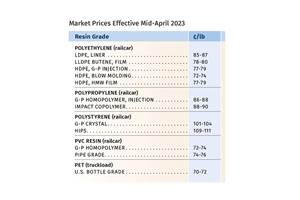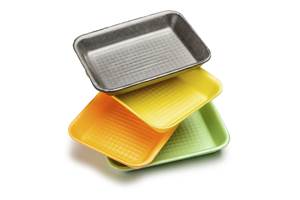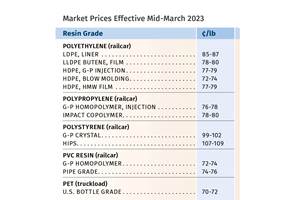Prices of Volume Resins Drop by Year-End
Entering 2025, prices of major commodity and volume resins are generally in a ‘buyer’s market.’
Prices dropped for nearly all volume resins heading to 2024’s end, signaling a buyer’s market, particularly as 2025 contract negotiations were taking place. Contributing factors included overall lackluster if not declining demand, along with lower key feedstock costs as well as lowered demand and pricing of exports.
A first-quarter transition was most likely looming due to a heavy plant turnaround schedule of key feedstocks and resins; the potential for a strike by the International Longshoreman’s Association (ILA) against the nation’s East and Gulf Coast ports in mid-January; and the uncertainty of the impact of tariffs on imports by the new U.S. presidential administration, though some industry sources venture that was perhaps more likely to affect end-use products versus pellets. Of course, unscheduled resin production outages due to weather-related or other global events are also an unknown.
These are the views of purchasing consultants from Resin Technology Inc. (RTi); senior analysts from Houston-based PetroChemWire (PCW); CEO Michael Greenberg of The Plastics Exchange (TPE); Scott Newell, executive vice president polyolefins at distributor/compounder Spartan Polymers; and Mike Burns of Plastic Resin Market Advisors.

PE Prices Down
Polyethylene (PE) contract prices in November were generally expected to drop further, following the 3¢/lb October decrease, according to PCW’s associate director for PE, PP and PS David Barry; TPE’s Greenberg; Mike Burns of Plastic Resin Market Advisors; and Kevin Mekaru, RTi’s senior business leader commodity plastics. Mekaru ventured there was potential for another 3 to 5¢/lb decrease within the November-December time frame. He and other sources noted that factors such as a glut of supplier inventory built up through the fourth quarter, a flat export market and a heavy schedule of first-quarter plant maintenance turnarounds, mean will be plenty of material available. Generally, a 6¢/lb decline was considered likely.
Still, all sources expected PE suppliers to issue an increase for January — historically a 5¢/lb markup has been the case for nearly a decade. Suppliers’ price nominations for October and November went by the wayside. Moreover, suppliers’ improved profit margins in 2024 with increases totaling 13¢/lb through September. PCW’s Barry noted that both domestic and export demand had slowed and that, even if they weren’t happening very transparently, price concessions were being made.
On the way to December, Plastic Resin Market Advisors’ Burns noted that reduced prices and improved resin availability in the secondary market signaled an aggressive approach to year-end price resets. “Processors should expect favorable pricing and additional opportunities to improve prices ahead of next year,” Burns said. “The timing of the Chinese New Year starting Jan. 29, 2025, and the potential January 15 port strike could support an early year inventory advantage to North American processors.”
Characterizing spot market participants as noticeably less enthusiastic, TPE’s Greenberg reported this going into December: “Pricing for all commodity PE resins held flat, though overall market sentiment remained negative,” Greenberg said. “There have been several other weeks of stability during this down leg of the current cycle which began in July. Our spot prime prices have fallen 5 to 7¢/lb during the break, and the market is still searching for a bottom.”
PCW’s Barry reported that NOVA was starting up its new AST2 unit near Sarnia, Ontario, and was supplying offgrade material to the market. The unit is expected to eventually produce octene-based LLDPE and mLLDPE grades, primarily for film applications. Braskem Idesa’s plant in Nanchital, Mexico, was expected to run at higher overall rates of around 85% in 2025, with the nearby ethane import terminal opening up in first quarter 2025. The plant is scheduled for a 30- to 40-day turnaround, though exact timing was not disclosed.
PP Prices Bottom Out

Polypropylene (PP) prices were expected to drop by 3 to 4¢/lb in November, in concert with propylene monomer prices, and were generally thought to have bottomed out after the combined 10¢/lb decline in the September-October time frame, according to PCW’s Barry, Spartan Polymers’ Newell, TPE’s Greenberg and Paul Pavlov, RTi’s vice president of PP and polyvinyl chloride (PVC). Some further price decline in December was also possible, according to Spartan Polymers’ Newell, who ventured that PP prices will be driven by demand and that an uptick in January, at least, was unlikely. “There was no clear impetus for a strong pickup in demand for PP in first quarter,” Barry reported.
Still, some of these sources ventured that first quarter monomer prices could rally as costs of non-PP derivatives might move up and due to a heavier schedule of planned winter-spring plant turnarounds for monomer and PP. As such, RTi’s Pavlov ventured that PP prices would be flat-to-up going into 2025. “The forward polymer-grade propylene market is priced above current levels,” TPE’s Greenberg said, “so we expect to see a higher trending market come January.”
However, Newell noted that none of the major PP suppliers had planned turnarounds scheduled, and barring an unscheduled production disruption, prices of PP could largely remain flat.
Going into December, Barry reported there were no unplanned outages, but suppliers were understood to be running at low rates in the 70s to match domestic orders. Formosa is said to be on track for first-quarter startup of its newest PP unit in Point Comfort, Texas. Barry also reported that while PP spot prices appeared to be stable, demand was seen as less robust, with some processors planning to idle facilities for as much as three weeks during the holiday season.
PS Prices Drop

Polystyrene (PS) prices in the November-December time frame were expected to be lower by 1 to 2¢/lb, after the 3¢/lb drop in October and their six-month rollover, according to PCW’s Barry and RTi’s Pavlov. Contributing factors are overall negative fundamentals, including slowed demand across all market sectors, along with lower costs of key feedstocks benzene and ethylene.
Barry noted that some market participants speculated that January could bring an uptick in prices — particularly driven by benzene. According to Barry, the implied styrene price based on a spot formula (30% ethylene, 70% benzene) going into December was at 35.5¢/lb — the seventh consecutive week within a band of 35 to 36¢/lb. The three major suppliers throttled back plant production down to the mid-to-high 50s, closely matching output to forecast demand. In operations news, Ineos Styrolution was understood to have restarted the smaller HIPS line in Channahon, Illinois, that was shut down since mid-July. Repairs to the larger HIPS line were expected to conclude in the first quarter of 2025.
PVC Prices Down

PVC prices dropped 1¢/lb in November, having fallen by 1 to 2¢/lb in October, while December-January prices were expected to be largely flat, according to RTi’s Pavlov. Demand has slowed both for domestic and exports sales, and suppliers have significant inventory built up. Plant operating rates were between the mid-70s to 80% ending the fourth quarter. Pavlov did not anticipate an uptick in demand through the first quarter and cited concerns about potential tariffs on PVC imports.
PET Prices Down

Polyethylene terephthalate (PET) prices dropped by another 2¢/lb in the November-December time frame, having fallen 3¢/lb within September-October based on lower raw material formulation costs, according to RTi’s Mekaru. He ventured that PET prices would be relatively flat in the first quarter. He continues to characterize the market as amply supplied, both in terms of domestic production and well-priced imports, with demand being softer. He noted that industry sources are concerned about potential tariffs on PET imports. “We know the new administration plans to impose significant tariffs on Chinese imported goods,” Mekaru said. “PET resin imports from Mexico are key to the U.S. supply chain, but some of these plants have been acquired by Chinese entities, so it will be interesting to see how tariffs will be applied in this type of situation.”
ABS Prices Flat
Acrylonitrile butadiene styrene (ABS) prices appeared to be ending fourth quarter as they largely did the previous quarter, however demand was softer, according to Mark Kallman, RTi’s v.p. of PVC, PET and engineering resins. In addition, feedstock prices were lower and low-cost ABS imports continued to be a competitive force. Kallman ventured ABS plant operating rates had dropped to about 80%. The major announcement by INEOS that it would permanently shutter its ABS production plant in Ohio is not likely to impact supply. “While that plant accounts for 18% to 20% of North American ABS production, the ABS imports are equal to that,” Kallman said. Of course, tariffs on those imports could alter the situation and perhaps rally suppliers to increase production rates, particularly if demand picks up.
PC Prices Down
Polycarbonate (PC) prices dropped by 5¢/lb in the early part of the fourth quarter and had potential to fall by a few more cents, particularly as 2025 contract negotiations were taking place, according to RTi’s Kallman. This after remaining flat or rising by 5¢/lb, in some cases, for third-quarter contracts. Demand in all key markets is down and key feedstock costs are lower. As previously reported, due to major new PC capacity brought on by China, SABIC has shut down one PC plant in Europe and Trinseo has sold a plant to China, which was being dismantled, only to be reassembled in China.
Prices of Nylon 6, 66 Drop
Prices of nylon 6 were flat through most of the third quarter, following second quarter increases of 7 to 9¢/lb. Moreover, going into the fourth quarter, flat pricing was likely to continue based on generally stable feedstock costs, according to RTi’s Mekaru.
Prices of nylon 66 through fourth quarter were expected to move from flat to down by 5¢/lb, give or take, according to RTi’s Kallman. He characterized demand as having dropped along with prices of key feedstocks and ample supplies. Evidence of this was the announcement by major nylon 66 player Ascend Performance Materials that it is permanently shutting down its South Carolina nylon 66 plant, which produces fiber and film. That production will be moved to the company’s large Pensacola, Florida, plant to be added to the nylon 66 molding production.
Related Content
Prices Flat-to-Down for All Volume Resins
This month’s resin pricing report includes PT’s quarterly check-in on select engineering resins, including nylon 6 and 66.
Read MorePP Prices May Plunge, Others Are Mostly Flat
PP prices appear on the verge a major downward trajectory, with some potential of a modest downward path for others.
Read MoreRecycled Content to be Incorporated in PS Foam Packaging
Pactiv Evergreen and Amsty announced a collaboration that will bring ISCC plus certified product into select food packaging.
Read MorePrices of Volume Resins Generally Flat or Lower
Exceptions in early March were PP and PS, which moved up solely due to feedstock constraints, along with slight upward movement in PVC and PET.
Read MoreRead Next
Prices of PE, PP, PVC Up; PS, PET Flat
While prices moved up for three of the five commodity resins, there was potential for a flat trajectory for the rest of the third quarter.
Read MorePrices Drop for All Five Commodity Resins
While PE price reductions were not as apparent, they too were following the year-end price trajectory of PP, PS, PVC and PET.
Read MorePrices Flat-to-Down for All Volume Resins
This month’s resin pricing report includes PT’s quarterly check-in on select engineering resins, including nylon 6 and 66.
Read More
























